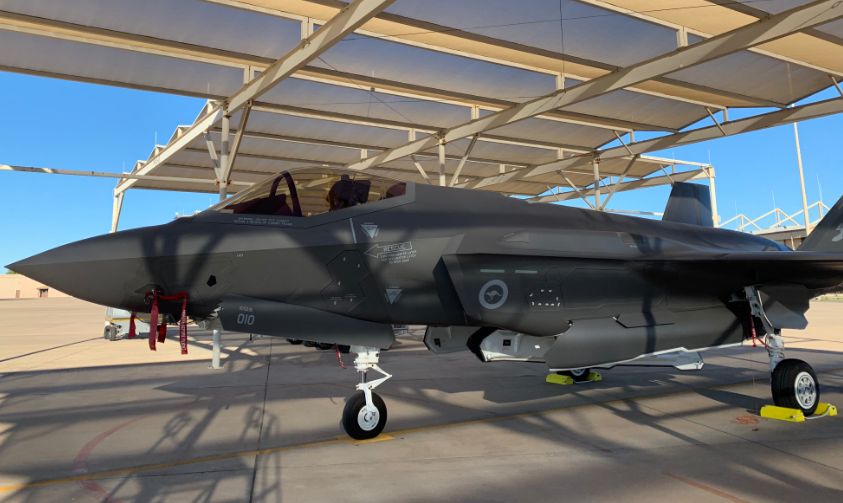Last year, the Royal Australian Air Force bid adieu to its archaic Classic Hornets that had served the country for about three decades and welcomed a new batch of the F-35 Joint Strike Fighters, with the total count now standing at 44.
The acquisition of the F-35 has come under the scanner as questions are being raised about its capability and viability for the Royal Australian Air Force.
In a fresh controversy, government documents have revealed that Australia’s F-35A fighter will spend less time in the air than previously anticipated, reported The Australian.
According to budget projections filed by the Department of Defense last week, the Joint Strike Fighters’ flying hours have been reduced by 25% this fiscal year.
The data has sparked a row with the opposition charging that the $16.6 billion fighter jet program was “plagued with issues” and demanding an answer from Defense Minister Peter Dutton.
“The (Joint Strike Fighters) aircraft are critical to Australia’s defense, and the fact that they are flying thousands of hours less than planned is a real concern,” opposition defense spokesman Brendan O‘Connor and assistant defense spokesman Pat Conroy said in a joint statement.

“How can Minister Dutton claim that he and the government have our troops’ backs when they cannot even ensure that JSFs are available for the hours budgeted?
“As always, it is the Australian Defense Force which suffers from a lack of availability of critical platforms due to the chronic mismanagement of Defense projects by this government,” they said.
This controversy comes even as Australia has been intensifying its military cooperation with the United States in the face of rising challenges from China in the Pacific region.
2021 – the end of an era.
At the end of this year our F/A-18A/B Classic Hornets are retiring from service, as we transition to the fifth-generation F-35A Lightning II.
Stay tuned for details on where & when you can see their final flying displays. #AusAirForce #FighterFriday pic.twitter.com/F1N2aiFDBJ
— Royal Australian Air Force (@AusAirForce) November 12, 2021
In 2002, Australia became a Level 3 industrial partner in the F-35 program. The RAAF had acquired 44 of its 72 F-35As by late 2021, and the final front-line unit, No. 75 Squadron at Tindal, Northern Territory, received its first aircraft in December. And by the end of 2023, the RAAF hopes to have all of its aircraft operational.
While speculation is rife that it will buy more F-35 aircraft after all the present ones are operational, the existing fleet has run into trouble. According to the documents cited by the newspaper, the expected flying hours for 2021-22 have been cut from 11,813 to 8773.
Further, the opposition Labor Party’s analysis found that flight hours were cut by 17%, 14%, and 13% in each of the next three fiscal years. The jets are expected to cost around $200 million each, excluding maintenance costs, it was pointed out.
Skepticism About RAAF’s F-35 Program
Experts in the US Air Force admit that the Lockheed Martin F-35 Joint Strike Fighter sold to the RAAF was a disaster. It was supposed to be a low-cost, light-weight, high-performance stealth fighter, but it isn’t, says Independent Australia.
The plane has a restricted range, low air-to-air combat survivability, and extremely expensive operating costs, costing US$100 million (AU$140 million) each jet.
There has also been significant skepticism around the utility of the Australian F-35 fighters to combat the Chinese threat. Pacific Air Forces’ commander Gen. Kenneth Wilsbach had told reporters that the aircraft with which Australia will agree – including F-35s, F-22s, and B-52s, as well as B-1s – will be deployed, as previously reported by the EurAsian Times.

However, the role of the F-35 has come under the scanner. Due to its combat range of just 1000 km, the fighter jet will require mid-air refueling, if it were to fly to Taiwan or closer to China to assist the American fighters in case of a contingency.
The RAAF’s biggest problem with fighting China would thus be its inability to get there, according to The Sydney Morning Herald.
Additionally, the F-35’s weakness, particularly for Australia, is its inability to carry the Long Range Anti-Ship Missile (LRASM). While Lockheed Martin, the F-35’s manufacturer is working on it, Australia has instead decided to outfit its 24 F/A-18F Super Hornets with the missiles.
Lockheed Martin Progressing Towards LRASM Integration On F-35 – https://t.co/m5qTQoYhWZ via @navalnewscom @xaviervav pic.twitter.com/TkYOCNXS5E
— Assoc. of Old Crows (@AOCrows) February 2, 2021
The addition of a long-range missile to the F-35s is a priority, according to Defense Minister Peter Dutton, but he also points out that “a lot of research and investment” is going into next-generation weapons which indicate that it will take a while for the upgrade to take place.
In 2019, two former Air Force chiefs revealed that the RAAF might require a new bomber, as the F-35 Joint Attack Fighter was insufficient for future strike operations.
In 2002, Australia joined the US-led F-35 program without any official evaluation or tender procedure. Many were surprised by the abrupt decision, as the then-Howard government had laid out a comprehensive decision-making process in its 2000 Defense White Paper, according to Lowy Institute.
The then-Air Force chief outlined the rationale behind the surprise rush to buy F-35s in public. Unfortunately, the F-35 began experiencing technical issues, cost increases, and protracted delays soon after the choice was made.
The suspicions surrounding the F-35 fighter of the Royal Australian Air Force when seen alongside the reduced flying hours raise some very important questions, strategic to Australia’s security. The government would do well to quell these doubts and provide more clarity.
- Contact the author at sakshi.tiwari9555@gmail.com
- Follow EurAsian Times on Google News




